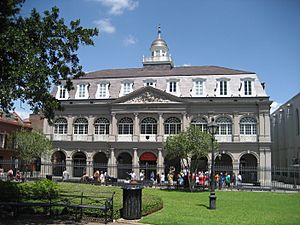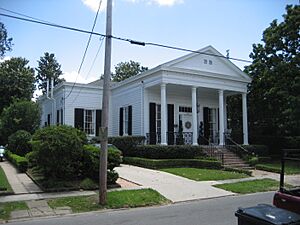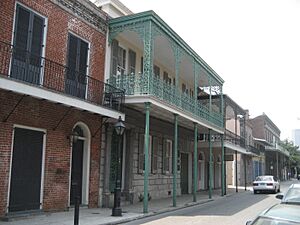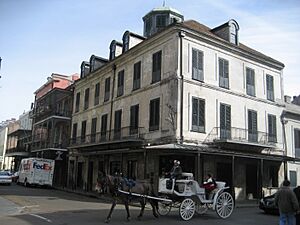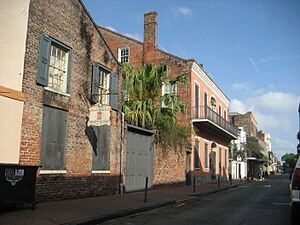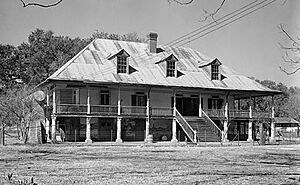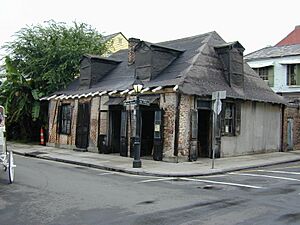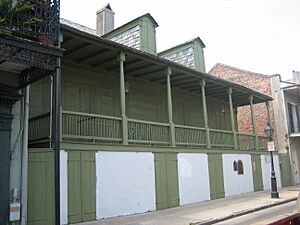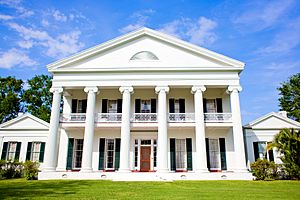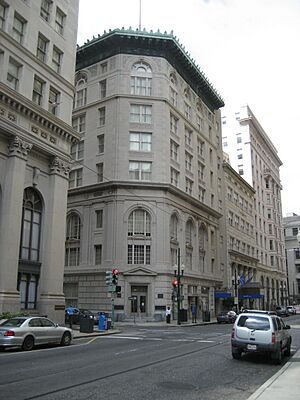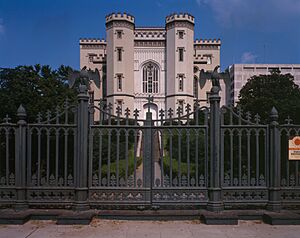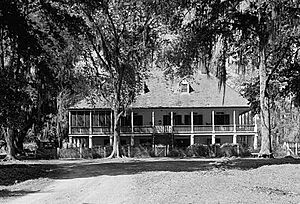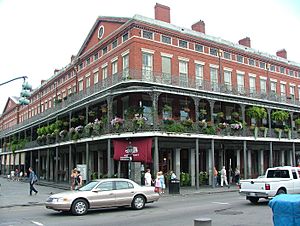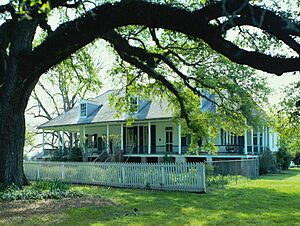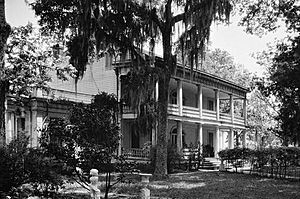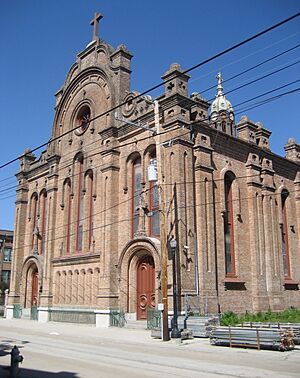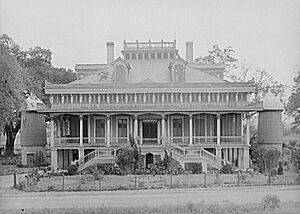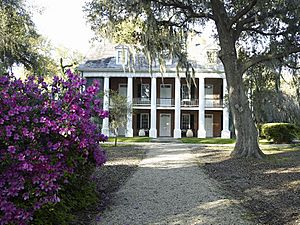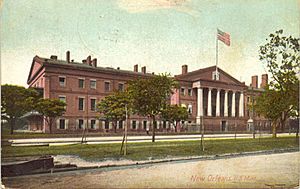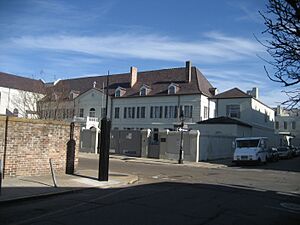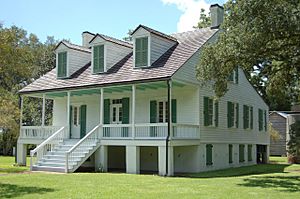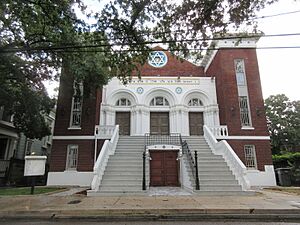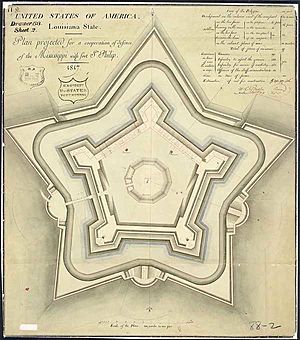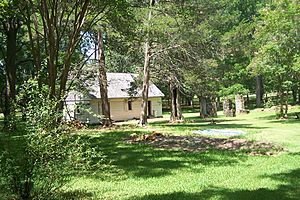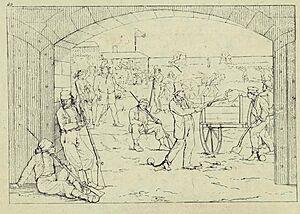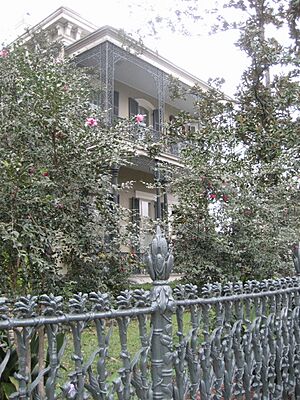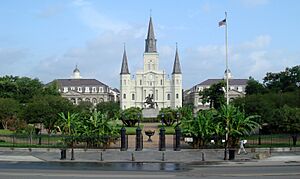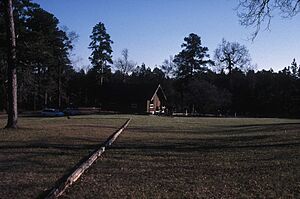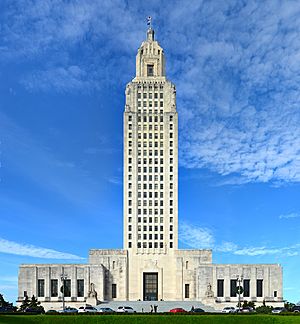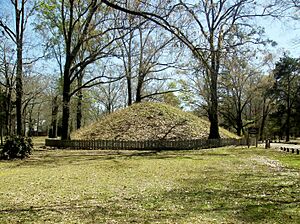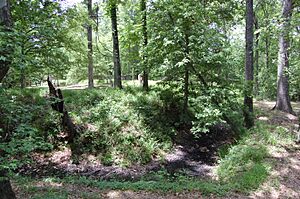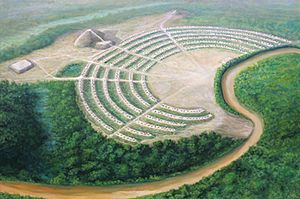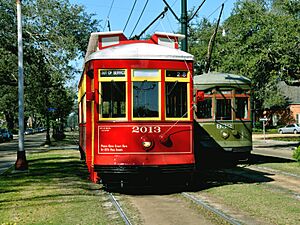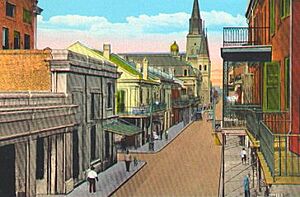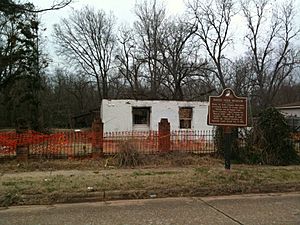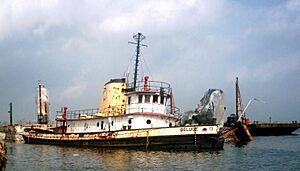List of National Historic Landmarks in Louisiana facts for kids
The state of Louisiana is home to many special places called National Historic Landmarks. These are buildings, areas, or objects that the United States National Park Service recognizes as super important to the history of the whole country. Think of them as national treasures!
Louisiana has 53 of these amazing landmarks. They cover a huge range of history, from ancient times to more recent years. The newest one added was the St. Charles Streetcar Line in August 2014. Sadly, three landmarks have had their special status removed over time. Also, a cool old steamboat called the Delta Queen used to be a landmark in Louisiana, but it moved to Chattanooga and is now a landmark in Tennessee.
Contents
Louisiana's National Historic Landmarks
Here are some of the incredible National Historic Landmarks you can find in Louisiana:
Historic Buildings and Homes
- Acadian House (St. Martinville): This old Acadian house is also known as Maison Olivier. It's part of the Longfellow–Evangeline State Historic Site, showing how early settlers lived.
- The Cabildo (New Orleans): This building from the late 1700s is right on Jackson Square. It used to be the city hall when Louisiana was a colony and in its early days as a state. Now, it's part of the Louisiana State Museum.
- George Washington Cable House (New Orleans): This charming cottage in the Garden District was once the home of famous author George Washington Cable.
- James H. Dillard House (New Orleans): This was the home of James H. Dillard, a teacher at Tulane University. He spent most of his life working to make education better for Black people in the United States.
- Evergreen Plantation (Wallace): This plantation has 37 buildings, including the main house and 22 old slave cabins. It's a great example of the large plantation complexes that existed in the Southern United States before the American Civil War. You can visit it today!
- Gallier Hall (New Orleans): Designed by James Gallier (Sr.) in the mid-1800s, this building was New Orleans' City Hall for many years. It's still used for important city events.
- Gallier House (New Orleans): This beautifully restored home was designed by James Gallier Jr..
- Nicholas Girod House (Napoleon House) (New Orleans): Built in 1797, this house was owned by former Mayor Nicholas Girod. He got it ready for a plan to rescue Napoleon from exile! That's why it's now known as the Napoleon House. Since 1914, it's been a restaurant.
- Hermann-Grima House (New Orleans): A historic house in the French Quarter.
- Homeplace Plantation House (Hahnville): Built around 1790, this is a large French Colonial style home. It's not open to the public.
- Lafitte's Blacksmith Shop (New Orleans): This old building from the late 1700s is a Creole cottage. It became a popular bar in the 20th century.
- Longue Vue House and Gardens (New Orleans): A beautiful estate with a house and gardens.
- Louisiana State Bank Building (New Orleans): An important historic bank building.
- Madame John's Legacy (New Orleans): This is one of the few French Colonial-style houses in the French Quarter that survived the big fires of the late 1700s. Its name comes from a story by George Washington Cable.
- Madewood Plantation House (Napoleonville): This was the first major building designed by architect Henry Howard, started in 1846.
- Magnolia Plantation (Derry): A historic plantation.
- New Orleans Cotton Exchange Building (New Orleans): This building was once a busy center for trading cotton.
- Oak Alley Plantation (Vacherie): Famous for its stunning alley of oak trees leading to the main house.
- Old Louisiana State Capitol (Baton Rouge): Designed by architect James H. Dakin, this building looks like a castle! It's known as "Castellated Gothic."
- Parlange Plantation House (Mix): A historic plantation house.
- Pontalba Buildings (New Orleans): These are two large, historic brick buildings on Jackson Square.
- The Presbytere (New Orleans): This iconic building on Jackson Square was planned in the 1790s. It was meant to be a twin to The Cabildo. Today, it's part of the Louisiana State Museum.
- Oakland Plantation (Natchez): A historic plantation.
- Rosedown Plantation (St. Francisville): A historic plantation with beautiful gardens.
- St. Alphonsus Church (New Orleans): A historic church in New Orleans.
- St. Mary's Assumption Church (New Orleans): A historic church in New Orleans.
- St. Patrick's Church (New Orleans): A historic church in New Orleans.
- San Francisco Plantation House (Reserve): A historic plantation house.
- Shadows-on-the-Teche (New Iberia): This beautiful Greek Revival home was finished in 1834. It stayed in the same family until 1958 and is now open for tours.
- Shreveport Municipal Memorial Auditorium (Shreveport): A historic auditorium.
- Shreveport Water Works Company, Pump Station (Shreveport): This pumping station is an important example of engineering.
- United States Customhouse (New Orleans): A historic custom house.
- John Minor Wisdom United States Court of Appeals Building (New Orleans): This courthouse, built in 1909, was where many important court cases during the Civil Rights Movement were decided.
- United States Mint, New Orleans Branch (New Orleans): This building used to make both gold and silver coins in the 1800s. It even briefly made coins for the Confederate States during the Civil War.
- Old Ursuline Convent (New Orleans): This Convent was built very early in the colonial era by Ursuline nuns. It's New Orleans' oldest surviving French Colonial building, dating back to 1752.
- Edward Douglass White House (Thibodaux): This was the home of Edward Douglass White, a famous judge.
- Agudath Achim Anshe Sfard Synagogue (New Orleans): This is a modern Orthodox Synagogue.
Historic Districts and Sites
- Courthouse and Lawyers' Row (Clinton): Built in the mid-1800s, this courthouse and five nearby law offices are great examples of Greek Revival architecture.
- Fort De La Boulaye Site (Phoenix): This fort was built in 1699–1700 when France took control of the mouth of the Mississippi River.
- Fort Jackson (Triumph): Built on the lower Mississippi River after the War of 1812, this fort was the site of a major battle in 1862. It's now a public park.
- Fort Jesup (Many): Fort Jesup was built between 1822 and 1832 to help protect the border between American and Spanish lands. Soldiers here watched over Texas until the Mexican–American War in 1846.
- Fort St. Philip (Triumph): This fort on the Mississippi River was established in the 1700s. It saw major battles during the War of 1812 and the American Civil War.
- Garden District (New Orleans): A famous neighborhood in New Orleans known for its beautiful homes and gardens.
- Jackson Square (New Orleans): This is the main square of the Vieux Carré (French Quarter). It was redesigned in the mid-1800s by Micaela Almonester, Baroness de Pontalba and renamed Jackson Square.
- Los Adaes (Robeline): From 1729 to 1770, Los Adaes was the capital of Tejas on the edge of New Spain. It included a mission and a fort.
- Louisiana State Capitol Building and Gardens (Baton Rouge): The current state capitol building.
- Marksville Prehistoric Indian Site (Marksville): This is an important archeological site for the Marksville culture, showing how ancient Native Americans lived.
- Melrose Plantation (Melrose): This plantation was created by a Black businesswoman named Marie Thérèse Coincoin. It might even have the first buildings in the United States designed by Black people for Black people.
- Natchitoches Historic District (Natchitoches): Natchitoches is the oldest permanent settlement in the lower Mississippi River Valley. It was founded by the French in 1714, even before New Orleans!
- Port Hudson (Port Hudson): This was an American Civil War battleground and the last Confederate stronghold on the Mississippi River.
- Poverty Point National Monument (Delhi): This is an ancient site with large earthworks built by Native Americans thousands of years ago.
- St. Charles Streetcar Line (New Orleans): This is the most extensive streetcar line in the country and the oldest continuously running light-rail line in the world!
- Vieux Carre Historic District (French Quarter) (New Orleans): Meaning "Old Square," this is the original 18th-century town of New Orleans. It's famous for its unique architecture and lively atmosphere.
Former National Historic Landmarks
Sometimes, a landmark might lose its special status. Here are a few that were once National Historic Landmarks in Louisiana:
- U.S.S. Cabot (New Orleans): This was an aircraft carrier used by the United States Navy and later by the Spanish navy. A museum foundation tried to save it, but they couldn't get enough money. The ship was eventually taken apart, and its landmark status was removed in 2001.
- Kate Chopin House (Cloutierville): This was the home of author Kate Chopin, who wrote about life in the bayou. Sadly, the house was destroyed by fire in 2008, so its landmark status was removed in 2015.
- DELUGE (Firefighting Tug) (New Orleans): The DELUGE was a fireboat that helped protect the Port of New Orleans. It was a great example of the large fireboats used in the 1920s. Its landmark status was removed in 2023.
National Park Service Areas in Louisiana
Besides the National Historic Landmarks, Louisiana also has several areas managed by the National Park Service. These places are often protected even more strongly than other landmarks.
- Cane River Creole National Historical Park
- Chalmette National Cemetery
- El Camino Real de los Tejas National Historic Trail
- Jean Lafitte National Historical Park and Preserve
- New Orleans Jazz National Historical Park
- Poverty Point National Monument
- Vicksburg National Military Park (which is also in Mississippi)


